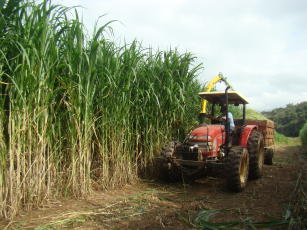Genetic breeding of elephant grass for forage use
Genetic breeding of elephant grass for forage use
In Brazil, the milk chain has about 4 million workers, with a herd of 23 million milked cows and national production estimated at 33.5 billion liters. The project results will contribute to addressing the general problem of “low efficiency of milk and beef production systems due to seasonality in forage production or forage gap period”, and the specific problems of the “need for forage cultivars for grazing”. that can minimize the effects of the feeding deficiency caused by the forage gap and promote an increase in animal productivity” and the “need for forage cultivars for silage production that can suppress at low cost the feeding deficiency in times of lower forage supply”. The use of elephant grass ( Cenchrus purpureus) helps to minimize these problems, as proven by the use of cultivars BRS Capiaçu and BRS Kurumi, which were released by the Embrapa breeding program. The former is a high-yield cultivar for silage production that is an alternative source of low-cost and good quality forage supplementation, and the latter is a cultivar for grazing that produces feed in adequate quantity and quality for dairy or beef cattle. This project was designed to give continuity to the “Embrapa Elephant Grass Genetic Improvement Program”, and aims to develop elephant grass cultivars for forage use that have high productivity, lower forage production seasonality, good nutritional value and adaptation to different environmental conditions. The project includes the innovation solutions entitled “Elephant Grass Cultivars for Grazing (SI-Pastejo)” and “Elephant Grass Cultivars for Silage (SI-Silage)”. The main results of SI-Pastejo are obtaining 4 cultivars (CNPGL-PAST-1, CNPGL-PAST-2, CNPGL-PAST-3 and CNPGL-PAST-4) with new characteristics that will favor its use for grazing, such as propagation by seeds, less seasonality of forage production and greater productivity. In SI-Silagem, two cultivars will be developed (CNPGL-SILO-1 and CNPGL-SILO-2) that will have new attributes such as the higher nutritional value of the silage. The extension of use of the BRS Capiaçu cultivar to the Amazon Biome will also be carried out in this SI. At the end of the 48 months of project conduction, the cultivars CNPGL-PAST-1, CNPGL-PAST-2 and CNPGL-SILO-1 will have a technological maturity level and BRS Capiaçu will be recommended for use in the Amazon Biome. To achieve these results, a test network will be assembled with the participation of the following research centers: Embrapa Dairy Cattle, Embrapa Temperate Agriculture, Embrapa Coastal Tablelands, Embrapa Rondônia, Embrapa Roraima and Embrapa Beef Cattle. The new cultivars will provide an increase in the efficiency of dairy and beef production systems, helping to minimize the effects of feeding deficiency caused by the seasonality of forage production or forage gap period. The use of the new cultivars will also allow an increase in milk and beef production, and a reduction in the amount of concentrate used in diets for dairy and beef cattle.
Status: In progress Start date: Thu Jul 01 00:00:00 GMT-03:00 2021 Conclusion date: Tue Dec 30 00:00:00 GMT-03:00 2025
Head Unit: Embrapa Dairy Cattle
Project leader: Francisco Jose da Silva Ledo
Contact: francisco.ledo@embrapa.br


